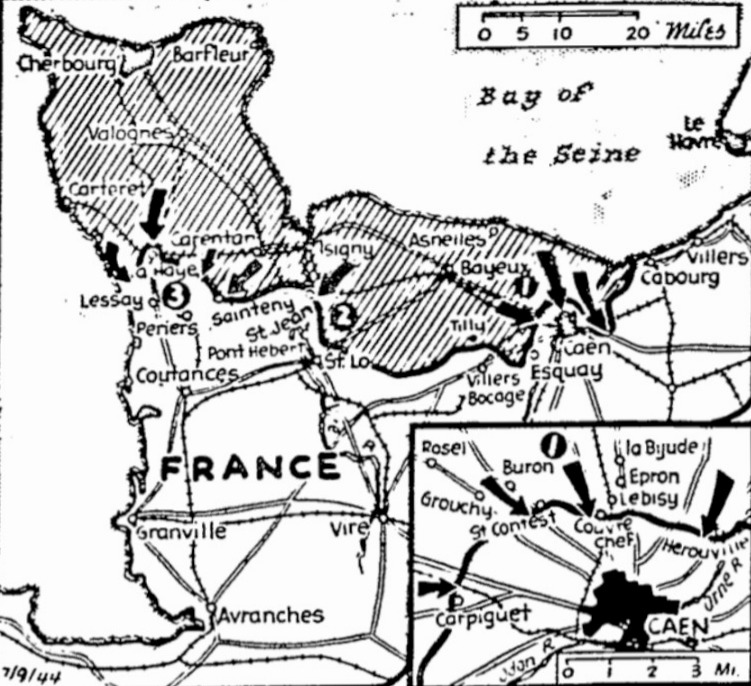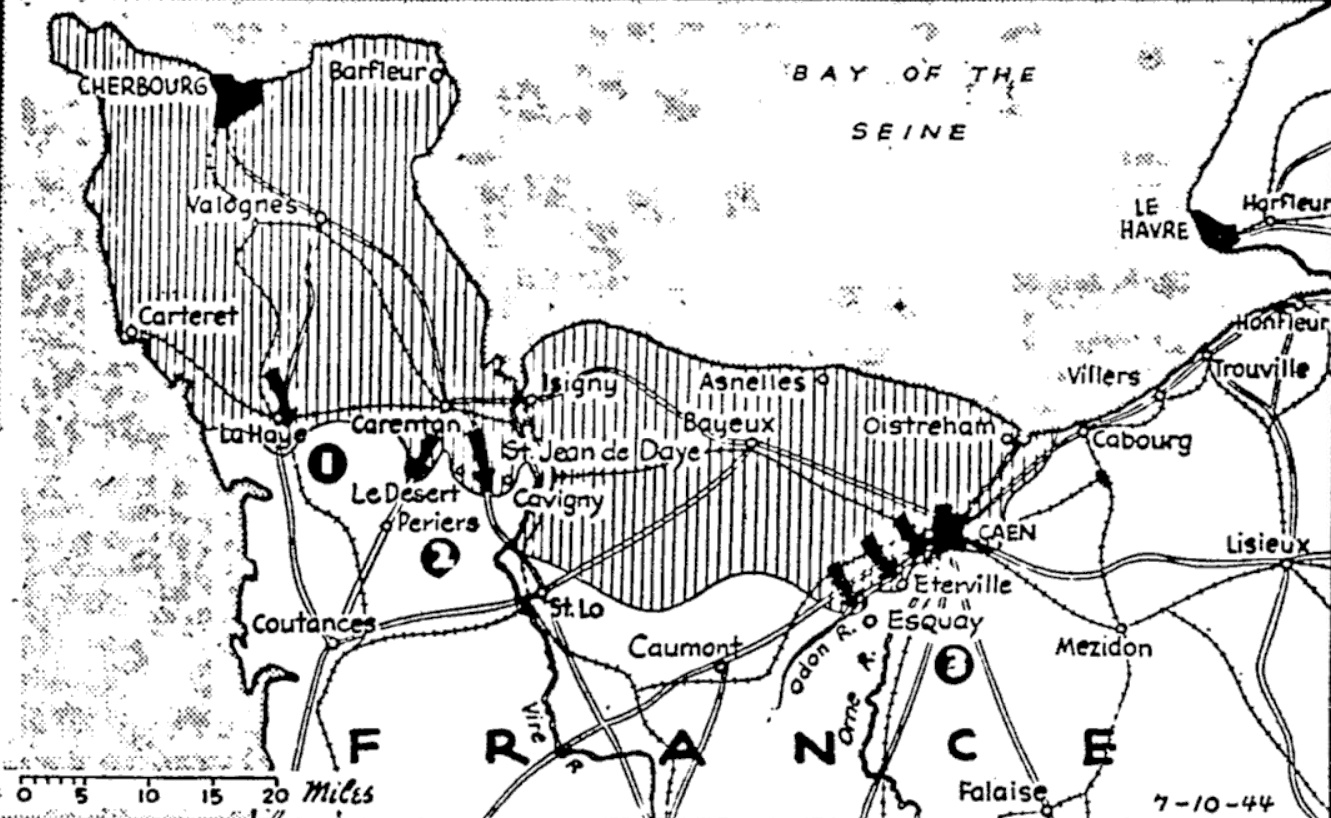The Pittsburgh Press (July 9, 1944)
NAZIS BEGIN CAEN WITHDRAWAL
Berlin hints at retreat as British forces drive near heart of port
Americans pierce German front in center, push into La Haye for fourth time
By Phil Ault, United Press staff writer

As the British drove forward into Caen and a decisive battle raged, the Nazi began withdrawing some forces from Caen indicating they were ready to evacuate that port (1). U.S. forces cut a hole in the center of the Nazi front (2) with the capture of Saint-Jean-de-Daye and drove near Pont-Hébert. U.S. forces again drove into La Haye-du-Puits and made new advances along both sides of that road junction (3).
SHAEF, London, England –
British troops smashed into Caen Saturday, sweeping through 12 suburban forts in a juggernaut offensive to within half a mile of the center of the city, and Berlin hinted that the Germans were abandoning the burned and battered bastion on the road to Paris.
Official Allied advices said that German big guns and tanks were on the move along the last two available roads out of Caen under fire of British and Canadian forces that had severed 12 highways serving the road center, indicating that evacuation of the city had begun.
Patrols may already have penetrated the inner city, and it appeared that Gen. Sir B. L. Montgomery’s British 2nd Army had met and mastered the main German force facing the French beachhead in a battle that may go down as one of the decisive actions of the war.
Yanks back in La Haye
U.S. troops at their end of the 120-mile offensive front swept into La Haye-du-Puits for the fourth time and on their east flank captured Saint-Jean-de-Daye, drilling a deep hole near the center of the German front.
Hundreds of German prisoners were taken as the British hacked through stone villages in Caen’s western, northern and northeastern outskirts where German resistance, fierce when the attack started before dawn, wilted late in the day under the overpowering assaults.
German heavy guns and tanks, it was indicated, were withdrawing to a new line below Caen and the Berlin radio, pessimistic throughout the day on the battle for the city, said last night that “it is not improbable we may shorten our lines by withdrawing them beyond Caen.”
Caen big as Cherbourg
Caen, with a population of 50,000, is as big as Cherbourg and ranks as France’s seventh port. It lies nine miles from the sea but has a large floating basin and huge docking space with outlets to the coast through the Orne River and Canal.
The 11:30 p.m. Allied communiqué reported steady gains were made Saturday on all active portions of the front, with the Americans back in La Haye and holding all high ground in the area.
After capturing Saint-Jean seven miles southeast of Carentan, the Yanks linked two spearheads in the central sector and plunged on south toward important Pont-Hébert through a hail of fire from 88mm and rocket shells, leaving the enemy’s main forts behind.
May change war’s course
But the flaming focal point of the entire battle area was Caen, where the British were slashing away at the buckle of the German front in fighting which an official commentator said might change the course of the war.
If Field Marshal Erwin Rommel’s main armored forces can be smashed in the present battle, the 120 miles to Paris may be covered far more swiftly than has been anticipated, it was said.
Late dispatches from the front said Canadian anti-tank gunners knocked out 17 German tanks yesterday. They reported the battle was largely an infantry and artillery operation and that the first thrust had cracked most of the strong ring of German defenses around Caen.
Attack on 7-mile front
The Tommies attacked on a seven-mile front running from southwest to north of Caen at Gen. Sir B. L. Montgomery’s favorite hour – about 4:30 a.m. under a waning room. More than 450 RAF heavy bombers and additional U.S. mediums had softened up the German defenses with almost 3,000 tons of bombs in high-precision attacks beginning at dusk Friday.
Just before the troops moved forward, hundreds of massed guns flashed through the blackness in a famous “Monty barrage.”
The British leaped to the attack from points little more than two miles from the heart of Caen in positions they had held since D-Day, but those last few thousand yards, bristling with fortifications, were as tough as any encountered by Gen. Montgomery’s veteran desert warriors.
The Germans fought back stubbornly, but late in the day the British had pushed froward their front from 2,500 yards to two miles, reaching within half a mile of the heart of the city at some points, front dispatches said.
Huge casualties reported
Captured in the advance were 12 fortified villages, including Galamanche (three miles north-northwest of Caen), La Bijude and Lébisey (both two miles north-northeast), Couvre-Chef (one-and-a-half miles north), Hérouville (two miles northeast), Épron (three miles north) and Buron and Gruchy (both three miles northwest). The closest approach to the center of Caen was believed from the Couvre-Chef direction, where a British spearhead reported well south of that station on the railroad to the coast.
Huge casualties were reported being inflicted on the Germans as the 2nd Army smashed forward with every type of arms including flamethrowers and flail tanks which acted as land-going minesweepers. Spokesmen cautioned that their own losses may prove severe.
Yanks back on offensive
Front dispatches said that the Yanks went back to the offensive along almost the full 40 miles of the western sector after a night-long barrage, scoring most heavily in the Saint-Jean-de-Daye sector.
Saint-Jean was occupied almost without resistance after the Yanks crashed in heavy force across the Vire River and the Vire-Taute Canal leading into it and joined forces in a surge toward Pont-Hébert, four and a half miles farther south.
Under the power and consistency of the American attacks, German resistance seemed to be wavering, a front dispatch from Henry T. Gorrell said, but was still well organized.
Gradually advancing
The Germans were still matching the Yanks almost blow for blow farther west, but Lt. Gen. Omar N. Bradley’s troops were gradually if not spectacularly forcing their way to the open country inland from the Cherbourg Peninsula.
On the coastal side of La Haye, they swept through Biémont, two and a half miles southwest, and drove on toward the estuary of the Ay River, where the sheltered harbor of Saint-Germain possessed landing facilities of some importance.
The Yanks cleaned out the entire western side of the Mont-Castre forest east of La Haye.
Five miles from Périers
Farther inland, the doughboys were only five miles from the junction of Périers at two points: near Le Plessis on the main road in from the north and in the Sainteny sector on the Carentan road from the northeast.
The Germans, although hard put to do it, were still reinforcing the American sector.
An Allied commentator, asked to describe the situation in La Haye, said:
It can’t be said that the city is fully liberated although the mayor holds in his hands a speech of welcome which he hopes to deliver shortly to American troops.

